Media
Summary
HD 106906 b is an exoplanet 336 light-years away, 11 times the size of Jupiter, and possibly an analog of our own not-yet-discovered Planet 9. Plus, a large body of water ice has been discovered on Mars, and we interview lead author Dan Berman of the Planetary Science Institute. Also included, stories on Jupiter, Uranus’s moons, a young galaxy, and how space weather impacts habitability.
Transcript
This is the Daily Space for today, Tuesday, December 15, 2020. I am your host, Dr. Pamela Gay.
And I am your host, Beth Johnson.
And we are here to put science in your brain.
Today we are going to be joined by guest Dan Berman, who has advanced the story of water on Mars with a new paper describing subsurface water ice that was revealed with radar data. Before we get to the interview we have a wealth of news to cover, that takes us from the beginning of the universe to space weather taking place right now.
In case you missed it, yesterday was a chaotic day in astronomy. In rapid succession, we had a solar eclipse, the Geminids meteor shower, and the Hayabusa2 team found sample chamber A contained a nice quantity of black grains and chunks from the asteroid Ryugu. While all these events took place, science also rolled on, with one of the weirdest new papers taking a look at an 11 Jupiter mass planet on a wild orbit around a binary star system.
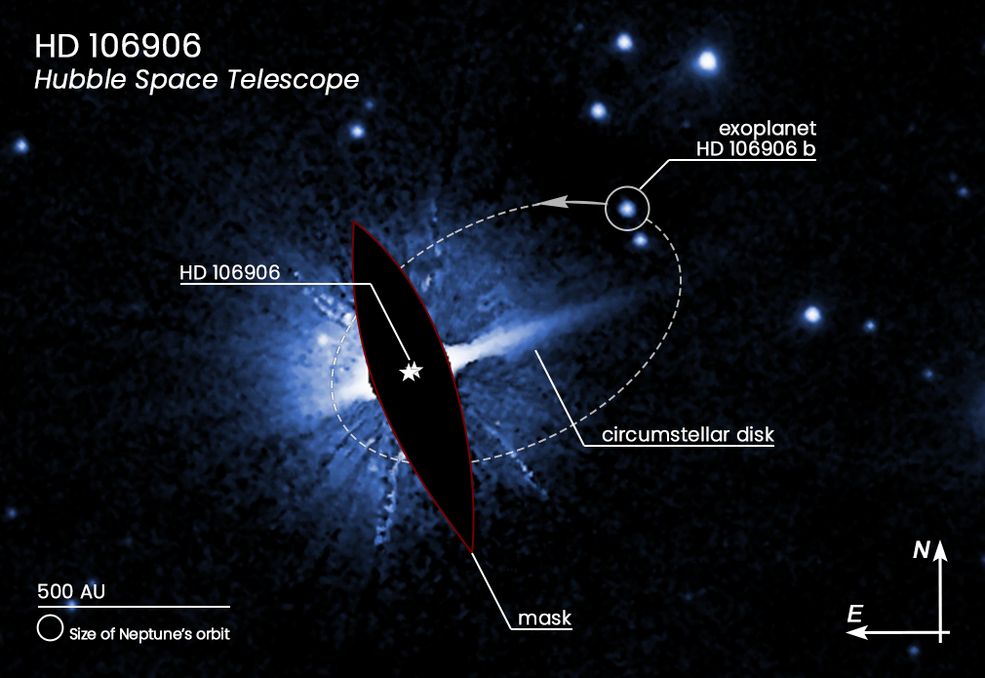
The two central stars are both hotter and larger than our Sun, and they are in a tight orbit such that they appear as a single star unless looked at spectroscopically. Surrounding the stars is a massive debris disk that caught astronomers’ eyes and, starting in 2005, their telescope time.
During a multi-year study, a faint spec was seen to co-move with the stars, leading a team led by Vanessa Baily to publish the discovery of a planet in a several hundred AU orbit. Now, with an even longer observing baseline, and the combined efforts of Hubble and several ground-based telescopes, this world has been charted to have an elliptical orbit that is highly inclined relative to the debris disk, and that orbit is actually stirring up the debris disk with every passage around the twin suns.
According to team member Robert de Rosa: The idea is that every time the planet comes to its closest approach to the binary star, it stirs up the material in the disk. So every time the planet comes through, it truncates the disk and pushes it up on one side. This scenario has been tested with simulations of this system with the planet on a similar orbit — this was before we knew what the orbit of the planet was.
We have never seen a planet in this kind of an orbit before; this is largely because our planetary searches aren’t sensitive to this kind of a world, so we really have no idea how common this kind of a planet might be. It could be very common, as we think our system may have a ninth planet out in the distant reaches of the solar system with an orbit not too different from what we’re seeing here.
In both cases, an encounter with two massive objects may be the reason for their weirdness. In the case of HD 106906 b, the migration was driven by the stars. According to a NASA press release: The prevailing theory is that it formed much closer to its stars, about three times the distance that Earth is from the Sun. But drag within the system’s gas disk caused the planet’s orbit to decay, forcing it to migrate inward toward its stellar pair. The gravitational effects from the whirling twin stars then kicked it out onto an eccentric orbit that almost threw it out of the system and into the void of interstellar space. Then a passing star from outside the system stabilized the exoplanet’s orbit and prevented it from leaving its home system.
For our own planet 9, interactions with Jupiter and Saturn may be to blame; it’s really hard to say until we find it.
So far no other exoplanets have been found orbiting with HD 106906 b. The star system is about 15 million years old, and other worlds are possible. When or if the JWST is able to launch, this system is a prime candidate for its infrared observing powers that would be able to detect other worlds the size of Saturn or larger. For now, our current understanding of this system is summarized in a paper in The Astrophysical Journal with first author Meiji Nguyen.
Back here, closer to Earth, we take a look at water on Mars. Now, water on Mars is nothing new. We know there are briny subsurface reservoirs on Mars. Earlier this year, three such lakes were found. In a new paper in the journal Icarus with lead author Dan Berman from our own Planetary Science Institute, researchers detail the finding of another large reservoir, this one of water ice.

Using data from the Shallow Radar (SHARAD) instrument aboard NASA’s Mars Reconnaissance Orbiter spacecraft, the team mapped what are called Viscous Flow Features (VFFs), which are ice-rich flow features in the southern hemisphere of Mars. These features showed a dense concentration in Nereidum Montes, along the northern rim of the Argyre basin. Located in this subregion are a large number of ice-rich deposits, the paper says, potentially the largest concentrations of any non-polar region in the southern hemisphere.
Further analysis shows that the deposit is almost entirely water ice. Berman explains: Our radar analysis shows that at least one of these features is about 500 meters thick and nearly 100 percent ice, with debris covering at most ten meters thick. This region would be an interesting landing site due to the large amounts of ice, which could be used as a source for water. Unfortunately, it is very mountainous terrain and it would likely be very difficult to land there.
Still, it’s good to know these regions exist on Mars. As Pamela and I say, where you find one, you usually find more. And of course, we’ll have Dr. Berman on after the news to talk about this discovery.
When I was in grad school, there were a lot of things we learned as “The universe is doing either this thing or this other thing,” as though the universe had to be limited in its options. One of those things was galaxy formation, which was described as either bottom-up or top-down, meaning either they formed through the merger of a lot of tiny systems or through the collapse of a massive cloud of gas and dust, to go from zero to a fully formed galaxy like Athena bursting from Zeus’s head.
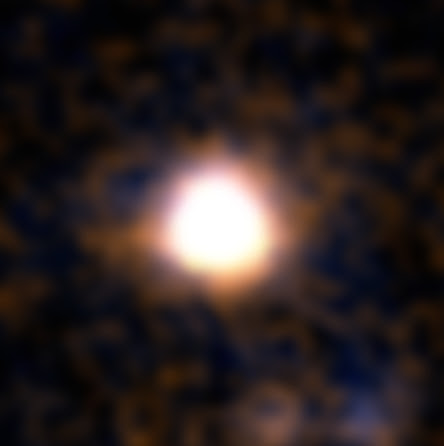
We know at least our own galaxy formed hierarchically, through the build-up of small systems into the larger barred-spiral we enjoy today.
Other systems, we keep finding, do actually take another path, and observations taken of the elliptical galaxy C1-23152 show that this distant elliptical galaxy seems to have formed by the time the universe was just 1.8 billion years old. Data from the Large Binocular Telescope highlights massive amounts of star formation that took place during the galaxy’s first 500 million years, leaving it to evolve as a red dead system not too different from the elliptical galaxies we see in our modern universe.
This work is published in The Astrophysical Journal with first author Paolo Saracco. According to co-author Francesco La Barbera: These observations showed that the formation of the most massive galaxies in the Universe can occur extremely quickly, through an extremely intense star formation process in the early Universe, as for C1-23152.
Co-author Adriana Gargiulo goes on to add: Understanding whether the scenario that describes the formation of C1-23152 is a particular case or whether, on the contrary, it is what happens for most of the most massive galaxies in the Universe is of fundamental importance since this would require a profound revision of the galaxy formation models.
Once again, the universe is telling us it’s not “either/or,” the answer is “and”.
Keeping with my usual planetary science theme, I take you now to Jupiter, where scientists have been using data from NASA’s Juno spacecraft to solve mysteries left from analysis of Galileo data taken 25 years ago.
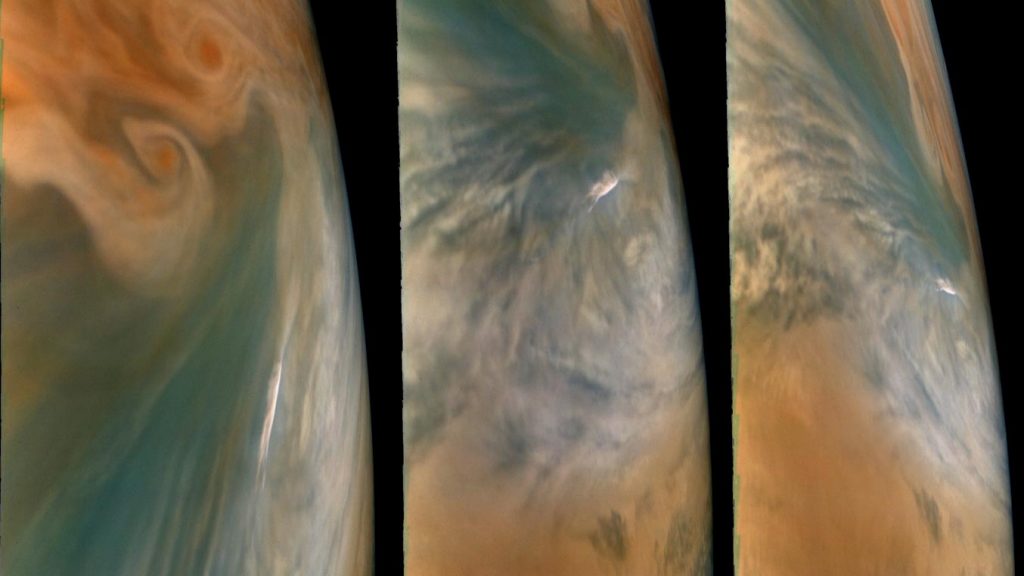
Think about how you imagine Jupiter from the images we have. Cloudy. Dense. Gassy. So unlike Earth, it’s honestly hard to imagine. The Galileo mission sent a probe into Jupiter to try and understand just how different the giant planet is, and the results were so surprising that they thought it was an anomaly. Basically, they thought the probe had gone into a “hot spot”, something as uncommon on Jupiter as it is here on Earth.
It turns out, though, that what they thought was a patch of hot, dense gas – localized atmospheric “deserts” that traverse the gas giant’s northern equatorial region – is actually just how the entire northern equatorial belt is. Per the press release: The implication is that the hot spots may not be isolated “deserts,” but rather, windows into a vast region in Jupiter’s atmosphere that may be hotter and drier than other areas. Juno’s high-resolution data show that these Jovian hot spots are associated with breaks in the planet’s cloud deck, providing a glimpse into Jupiter’s deep atmosphere.
This dry atmosphere may be the cause of the shallow lightning and mushballs reported on earlier this year. Tristan Guillot, a Juno co-investigator, explains: High up in the atmosphere, where shallow lightning is seen, water and ammonia are combined and become invisible to Juno’s microwave instrument. This is where a special kind of hailstone that we call ‘mushballs’ are forming. These mushballs get heavy and fall deep into the atmosphere, creating a large region that is depleted of both ammonia and water. Once the mushballs melt and evaporate, the ammonia and water change back to a gaseous state and are visible to Juno again.
So. Jupiter’s atmosphere is drier and hotter than previously thought. And we still have more to learn and understand.
While Beth talks about our solar system, I find myself returning again to discussing exoplanets: specifically exoplanets that may orbit the closest star to our Sun, Proxima Centauri. In a new study of this star using radio telescopes, astronomers have realized that this red-dwarf star is even more violent than previously thought. This has consequences for the two or more possible planets that orbit in this system. This work was led by Andrew Zic, who was able to link optical flares from Proxima Centauri with radio bursts.
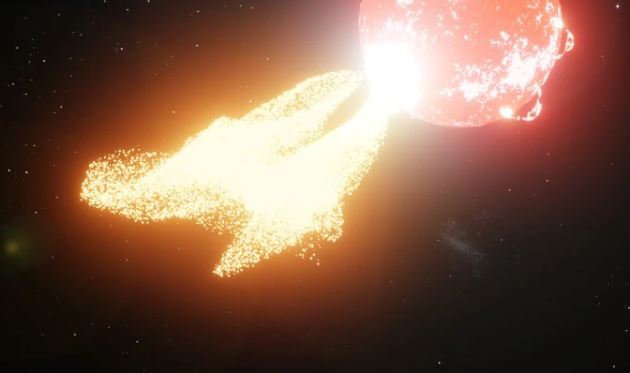
This linkage has been previously seen with our Sun. According to Zic: Our own Sun regularly emits hot clouds of ionized particles during what we call ‘coronal mass ejections’. But given the Sun is much hotter than Proxima Centauri and other red-dwarf stars, our ‘habitable zone’ is far from the Sun’s surface, meaning the Earth is a relatively long way from these events.
Mercury is not someplace you want to be when the Sun acts out, but with Proxima Centauri, even Mercury’s orbit is too big to keep it within the habitable zone. The terrestrial world orbiting Proxima Cen is just 0.05 AU from the star, and its orbit is just 11.2 days long. At this distance, Zic says: This is probably bad news on the space weather front. It seems likely that the galaxy’s most common stars – red dwarfs – won’t be great places to find life as we know it.
So if you are working on some great fiction describing a civilization just 4.2ly away, know that your fiction needs life that is down with being radiated and okay with experiencing all the nasty weather we know comes with being a tidally locked world. While life may find a way, it likely won’t be something we have so far anticipated.
We talk a lot about habitability here on Daily Space, between exoplanets and icy moons in our own solar system. Of late, we’ve been particularly focused on Europa and Enceladus, and if you’ve been watching our Minecraft Monday show, you know I’ve been a little hyped about Ganymede.
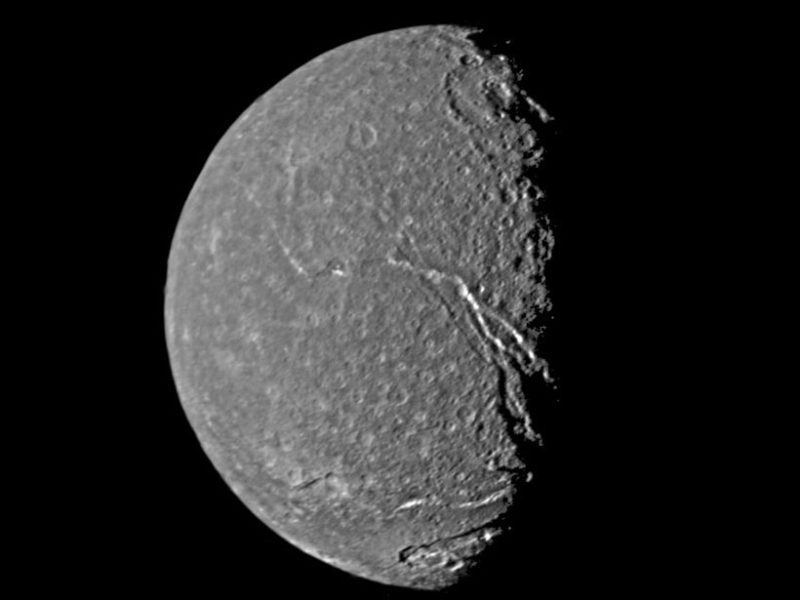
With all this excitement about the moons of Jupiter and Saturn, it seems some scientists didn’t like that Uranus’ and Neptune’s moons were left out of the fun. Being presented today at the AGU’s Fall Meeting, Benjamin Weiss, a planetary scientist at the Massachusetts Institute of Technology, looked at images from Voyager of several of Uranus’ moons. Per the article: Those images revealed that the moons are made of a roughly 50:50 combination of rock and ices and, like most planetary satellites, have many craters. However, the moons’ surfaces also display some of the classic signs of cryovolcanism, like fresh uncratered material and ridges, valleys, and folds.
Using the same techniques that led us to realize both Europa and Callisto, another of Jupiter’s Galilean moons, had subsurface oceans, the team calculated the possible strength of a magnetic field induced by Uranus on its moons. The story goes on to explain: As a moon orbits a planet, it also travels through the planet’s magnetic field, which isn’t the same strength or direction everywhere. The moon “feels” a changing magnetic field, which is a process that generates an electrical current.
How does that lead us to water? Water carries electric currents quite easily, and if the moon has water, and that water is carrying the current, it induces its own, smaller magnetic field. That smaller magnetic field could theoretically be detected by a magnetometer on a spacecraft near the moons. The calculations from the team showed that “A subsurface ocean on Miranda, Ariel, Umbriel, and Titania would be well within the measurement capabilities of current spacecraft technology, although Oberon’s field might be right on the edge of detectability.”
Once again, I beg the powers that be to fund an orbiter to Uranus. Please.
[Interview – No transcript available.]

Thank you from me as well, Dr. Berman. To close out, let me give you a few reminders. While the peak of the Geminids has already happened, the shower lasts another few days. And the Jupiter-Saturn conjunction is getting closer and closer, so please, if you have a clear sky, take a moment to look up.
Also, our first book club pick, Packing for Mars by Mary Roach, will be reviewed and discussed in the first week of January. Annie has already finished it, and I’m waiting for my copy from the library. Join us in that discussion on January 8.
Speaking of next year, this year that shall not be named is almost over, and we’re working to budget for next year. We need your help. Our goal is to sign up 60 new Patreon members by the end of this month, and we are halfway there and halfway through the month. If you are doing okay and have the financial ability to support us and our science, please consider signing up at Patreon.com/CosmoQuestX.
This has been the Daily Space.
Learn More
Hubble Pins Down Weird Exoplanet with Far-Flung Orbit
- NASA press release
- UC Berkeley press release
- Hubblesite press release
- “First Detection of Orbital Motion for HD 106906 b: A Wide-separation Exoplanet on a Planet Nine–like Orbit,” Meiji M. Nguyen, Robert J. De Rosa, and Paul Kalas, 2020 Dec 10, The Astronomical Journal
Ice-Rich Flow Features in Martian Southern Hemisphere Reveal Effects of Recent Climate Cycles
- PSI press release
- “Ice-rich landforms of the southern mid-latitudes of Mars: A case study in Nereidum Montes,” Daniel C.Berman, Frank C.Chuang, Isaac B.Smith, and David A. Crown, 2021 February, Icarus
That young but already evolved entirely self-made galaxy
- LBTO news
- “The Rapid Buildup of Massive Early-type Galaxies: Supersolar Metallicity, High Velocity Dispersion, and Young Age for an Early-type Galaxy at z = 3.35,” Paolo Saracco et al., 2020 December 10, The Astrophysical Journal
NASA’s Juno Spacecraft Updates Quarter-Century Jupiter Mystery
Space weather discovery puts ‘habitable planets’ at risk
- The University Of Sydney press release
- “A Flare-type IV Burst Event from Proxima Centauri and Implications for Space Weather,” Andrew Zic et al., 2020 December 9, The Astrophysical Journal
Do Uranus’s Moons Have Subsurface Oceans?
Credits
Written by Pamela Gay and Beth Johnson
Hosted by Pamela Gay and Beth Johnson
Audio and Video Editing by Ally Pelphrey
Content Editing by Beth Johnson
Intro and Outro music by Kevin MacLeod, https://incompetech.com/music/


 We record most shows live, on Twitch. Follow us today to get alerts when we go live.
We record most shows live, on Twitch. Follow us today to get alerts when we go live.